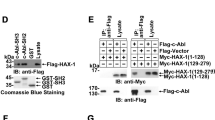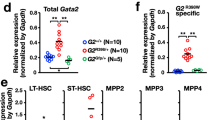Abstract
Autosomal recessive severe congenital neutropenia (SCN)1 constitutes a primary immunodeficiency syndrome associated with increased apoptosis in myeloid cells2,3, yet the underlying genetic defect remains unknown. Using a positional cloning approach and candidate gene evaluation, we identified a recurrent homozygous germline mutation in HAX1 in three pedigrees. After further molecular screening of individuals with SCN, we identified 19 additional affected individuals with homozygous HAX1 mutations, including three belonging to the original pedigree described by Kostmann1. HAX1 encodes the mitochondrial protein HAX1, which has been assigned functions in signal transduction4 and cytoskeletal control5,6. Here, we show that HAX1 is critical for maintaining the inner mitochondrial membrane potential and protecting against apoptosis in myeloid cells. Our findings suggest that HAX1 is a major regulator of myeloid homeostasis and underline the significance of genetic control of apoptosis in neutrophil development.
This is a preview of subscription content, access via your institution
Access options
Subscribe to this journal
Receive 12 print issues and online access
$209.00 per year
only $17.42 per issue
Buy this article
- Purchase on Springer Link
- Instant access to full article PDF
Prices may be subject to local taxes which are calculated during checkout




Similar content being viewed by others
Accession codes
Accessions
GenBank/EMBL/DDBJ
References
Kostmann, R. Infantile genetic agranulocytosis (Agranulocystosis infantilis hereditaria): a new recessive lethal disease in man. Acta Paediatr. 45 (Suppl.), 1–78 (1956).
Carlsson, G. et al. Kostmann syndrome: severe congenital neutropenia associated with defective expression of Bcl-2, constitutive mitochondrial release of cytochrome c, and excessive apoptosis of myeloid progenitor cells. Blood 103, 3355–3361 (2004).
Cario, G. et al. Heterogeneous expression pattern of pro- and anti-apoptotic factors in myeloid progenitor cells of patients with severe congenital neutropenia treated with granulocyte colony-stimulating factor. Br. J. Haematol. 129, 275–278 (2005).
Suzuki, Y. et al. HAX-1, a novel intracellular protein, localized on mitochondria, directly associates with HS1, a substrate of Src family tyrosine kinases. J. Immunol. 158, 2736–2744 (1997).
Gallagher, A.R., Cedzich, A., Gretz, N., Somlo, S. & Witzgall, R. The polycystic kidney disease protein PKD2 interacts with Hax-1, a protein associated with the actin cytoskeleton. Proc. Natl. Acad. Sci. USA 97, 4017–4022 (2000).
Radhika, V., Onesime, D., Ha, J.H. & Dhanasekaran, N. Gα13 stimulates cell migration through cortactin-interacting protein Hax-1. J. Biol. Chem. 279, 49406–49413 (2004).
Welte, K., Zeidler, C. & Dale, D. Severe congenital neutropenia. Semin. Hematol. 43, 189–195 (2006).
Dale, D.C. et al. Mutations in the gene encoding neutrophil elastase in congenital and cyclic neutropenia. Blood 96, 2317–2322 (2000).
Sharp, T.V. et al. K15 protein of Kaposi's sarcoma-associated herpesvirus is latently expressed and binds to HAX-1, a protein with antiapoptotic function. J. Virol. 76, 802–816 (2002).
Cilenti, L. et al. Regulation of HAX-1 anti-apoptotic protein by Omi/HtrA2 protease during cell death. J. Biol. Chem. 279, 50295–50301 (2004).
Elsner, J., Roesler, J., Emmendörffer, A., Lohmann-Matthes, M.L. & Welte, K. Abnormal regulation in the signal transduction in neutrophils from patients with severe congenital neutropenia: relation of impaired mobilization of cytosolic free calcium to altered chemotaxis, superoxide anion generation and F-actin content. Exp. Hematol. 21, 38–46 (1993).
Carlsson, G. & Fasth, A. Infantile genetic agranulocytosis, morbus Kostmann: Presentation of six cases from the original “Kostmann family” and a review. Acta Paediatr. 90, 757–764 (2001).
Horwitz, M., Benson, K.F., Person, R.E., Aprikyan, A.G. & Dale, D.C. Mutations in ELA2, encoding neutrophil elastase, define a 21-day biological clock in cyclic haematopoiesis. Nat. Genet. 23, 433–436 (1999).
Gilman, P.A., Jackson, D.P. & Guild, H.G. Congenital agranulocytosis: prolonged survival and terminal acute leukemia. Blood 36, 576–585 (1970).
Rosenberg, P.S. et al. The incidence of leukemia and mortality from sepsis in patients with severe congenital neutropenia receiving long-term G-CSF therapy. Blood 107, 4628–4635 (2006).
Dong, F. et al. Mutations in the gene for the granulocyte colony-stimulating-factor receptor in patients with acute myeloid leukemia preceded by severe congenital neutropenia. N. Engl. J. Med. 333, 487–493 (1995).
Green, D.R. & Kroemer, G. The pathophysiology of mitochondrial death. Science 305, 626–629 (2004).
Newmeyer, D.D. & Ferguson-Miller, S. Mitochondria: releasing power for life and unleashing the machineries of death. Cell 112, 481–490 (2003).
Maianski, N.A. et al. Functional characterization of mitochondria in neutrophils: a role restricted to apoptosis. Cell Death Differ. 11, 143–153 (2004).
Kroemer, G. & Reed, J.C. Mitochondrial control of cell death. Nat. Med. 6, 513–519 (2000).
Gross, A., McDonnell, J.M. & Korsmeyer, S.J. BCL-2 family members and the mitochondria in apoptosis. Genes Dev. 13, 1899–1911 (1999).
Opferman, J.T. & Korsmeyer, S.J. Apoptosis in the development and maintenance of the immune system. Nat. Immunol. 4, 410–415 (2003).
Hamasaki, A. et al. Accelerated neutrophil apoptosis in mice lacking A1-a, a subtype of the bcl-2-related A1 gene. J. Exp. Med. 188, 1985–1992 (1998).
Maianski, N.A., Mul, F.P.J., van Buul, J.D., Roos, D. & Kuijpers, T.W. Granulocyte colony-stimulating factor inhibits the mitochondria-dependent activation of caspase-3 in neutrophils. Blood 99, 672–679 (2002).
Dufva, M., Olsson, M. & Rymo, L. Epstein-Barr virus nuclear antigen 5 interacts with HAX-1, a possible component of the B-cell receptor signalling pathway. J. Gen. Virol. 82, 1581–1587 (2001).
Kawaguchi, Y. et al. Interaction of Epstein-Barr virus nuclear antigen leader protein (EBNA-LP) with HS1-associated protein X-1: implication of cytoplasmic function of EBNA-LP. J. Virol. 74, 10104–10111 (2000).
Yedavalli, V.S. et al. Human immunodeficiency virus type 1 Vpr interacts with antiapoptotic mitochondrial protein HAX-1. J. Virol. 79, 13735–13746 (2005).
Cottingham, R.W., Jr., Idury, R.M. & Schäffer, A.A. Faster sequential genetic linkage computations. Am. J. Hum. Genet. 53, 252–263 (1993).
Schäffer, A.A., Gupta, S.K., Shriram, K. & Cottingham, R.W. Jr. Avoiding recomputation in linkage analysis. Hum. Hered. 44, 225–237 (1994).
Klein, C., Bueler, H.R. & Mulligan, R.C. Comparative analysis of genetically modified dendritic cells and tumor cells as therapeutic cancer vaccines. J. Exp. Med. 191, 1699–1708 (2000).
Acknowledgements
We are indebted to the participants and their families and to M. Ballmaier and C. Reimers (Central Medical School Hannover, Flow Cytometry Laboratory) for their assistance. We thank all colleagues referring and registering patients at the International SCN Registry. We wish to acknowledge the genetic studies performed by M. Entesarian, K. Ericson and M. Nordenskjöld. Plasmid K83.pHCMV-GALVenv was a gift from C. Baum (Hannover Medical School). This study was supported by a grant from the Deutsche Forschungsgemeinschaft (DFG-KliFo 110), by the German José Carreras Leukemia Foundation, by the Bundesministerium für Bildung und Forschung (Congenital Bone Marrow Failure Syndromes) and in part by the Intramural Research program of the US National Institutes of Health, National Library of Medicine.
Author information
Authors and Affiliations
Contributions
C.K. designed and directed the study; obtained clinical samples; taught and supervised G.A., I.S., K.B., C.R. and G.B.; provided laboratory resources and wrote the manuscript with help from B.G. and A.A.S. The manuscript was then reviewed and approved by all authors. M. Grudzien did the genotyping for linkage analysis and sequenced candidate genes. G.A. performed all gene transfer studies and functional assays on myeloid cells and fibroblasts. M. Germeshausen sequenced HAX1, ELA2 and CSFR3 and comprehensively analyzed genetic data. I.S. discovered the first HAX1 mutation and performed sequencing and protein blotting. A.A.S. chose markers to genotype in the linkage region and performed linkage analysis computations. K.B. performed functional immunological assays. C.R. performed functional neutrophil studies and taught G.A. C.Z. cared for patients and collected and curated data in the SCN patient registry. B.S. collected and curated data in the SCN patient registry. N.R. treated patients in Iran and ascertained their samples for this study. G.B. performed functional neutrophil studies and sequenced candidate genes. G.C. and J.-I.H. initiated the Swedish Kostmann family project; G.C. treated the patients, and J.-I.H. and J.P. supervised the project with the support of B.F. N.D. was responsible for Swedish Kostmann gene studies. M.M. sequenced genomic samples from the Kostmann family. B.G. provided laboratory resources, organized patient samples, supervised M. Grudzien and assisted A.A.S. K.W. provided laboratory resources and resources for SCN registry and helped to initiate and carry out the study. M. Grudzien and G.A. contributed equally to this work and are considered acquo loco.
Corresponding author
Ethics declarations
Competing interests
The authors declare no competing financial interests.
Supplementary information
Supplementary Fig. 1
Germline HAX1 mutation in members of the original Kostmann pedigree. (PDF 433 kb)
Supplementary Fig. 2
Increased apoptosis and enzymatic caspase 3/7 activity in HAX1-deficient granulocytes. (PDF 965 kb)
Supplementary Fig. 3
Increased loss of mitochondrial membrane potential ΔΨm in HAX1-deficient fibroblasts. (PDF 743 kb)
Supplementary Table 1
Immunological analysis of HAX1-deficient patients. (PDF 65 kb)
Supplementary Table 2
HAX2 genomic PCR primers and conditions. (PDF 52 kb)
Rights and permissions
About this article
Cite this article
Klein, C., Grudzien, M., Appaswamy, G. et al. HAX1 deficiency causes autosomal recessive severe congenital neutropenia (Kostmann disease). Nat Genet 39, 86–92 (2007). https://doi.org/10.1038/ng1940
Received:
Accepted:
Published:
Issue Date:
DOI: https://doi.org/10.1038/ng1940



